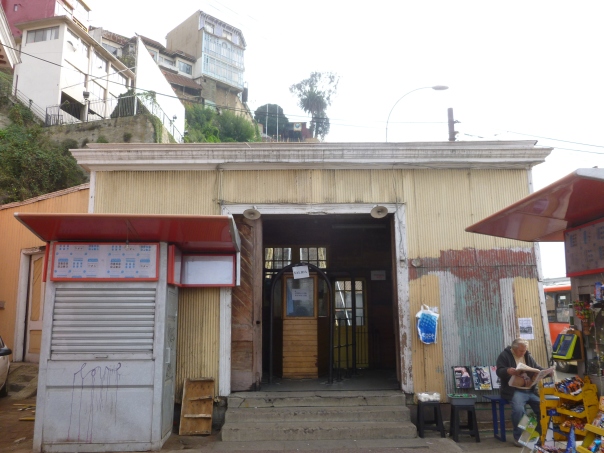Blog Archives
Los Ascensores de Valparaiso
One of the most distinguishing features of Valparaiso, Chile are the ascensores that scale the city’s many hills. Although ascensores translates literally as elevators or lifts, these are really funicular railways, where each track has one car, and they move equally and oppositely to counterbalance each other.

This is the view from “our” ascensor, Artilleria, which connected the edge of the city centre with Cerro Artilleria (Artillery Hill), where our B&B was located. It is probably the most famous one because it is most visible and has the best views!
There are many different numbers in circulation, but it is clear that approximately 25-30 ascensores once operated in Valparaiso, almost all built during the city’s heydays between about 1880 and the pivotal 1914 when the Panama Canal opened and sealed Valpo’s fate – see Wikipedia’s list. Most of the ascensores link the city centre on the bustling flats next to the port with the more residential areas in the first tier of hills – see the map at this local website (in Spanish).
Even though Valparaiso seems like a clear cousin of San Francisco, if you put the Pacific aside for a moment, the funiculars and the hills and accompanying ravines in between actually reminded me quite a lot of Pittsburgh. In Wikipedia’s list of funicular railways in the world, Pittsburgh looks to be the city with the second-most (17) after Valpo. While much poorer than Pittsburgh, Valpo shared a sort of run-down quality to some of the hills of Pittsburgh, a quality which is lacking in San Francisco!

This is the Ascensor Reina Victoria. Unlike Artilleria, this was a little harder to find, back from the waterfront.
Equally hard to discern is the number actually operating now, reportedly somewhere between four and eight. We actually rode on three and saw at least one other one that appeared to be working, as well as one that had only stopped a couple of weeks prior due to a mechanical failure.

This one was just closed recently, apparently awaiting the right parts for repair. You can see from the condition of the building that it is in the more popular and wealthier area that is full of boutique hotels.
Although they are a much-loved icon, they are old and in need of investment in a very, very poor city – and I can imagine that parts and skills to repair them may be hard to come by. Still, it seems like the government has plans to fix them up – see this BBC Mundo piece from 2012. I would certainly think it would be worthwhile to restore them, not only for tourism but also for locals, as driving up the steep and rough roads is not for the faint of heart (just ask Astrid!).

This is the headhouse at the top of the one of the longer-dormant ones – the whole thing will have to be rebuilt if it is to be restored, and don’t forget that this is earthquake country!
We took Ascensor Artilleria a couple of times, so I’ll give you a little more of a tour of that one. They do look quite nice lit up at night, although we didn’t get any pictures of that I’m afraid. The prices range from 100-300 pesos ($0.20-$0.60) per ride.

This is the entrance at the bottom – for the city’s most tourist-focused attraction, it could be a little more welcoming…

…but the inside is also a little rough around the edges, including the ability to see through the small gaps in the wood-plank floor! We heard someone refer to them as climbing boxes, and they are really as simple as that.

Evidence of earthquakes past? The tracks are a little wobbly,but these have been reliably moving Valpo up and down the hills for well over 100 years!
Seeing and riding these definitely was a highlight of Valparaiso, and they add a lot to the fabric of the city. I hope they can find the money to restore more of these soon!


